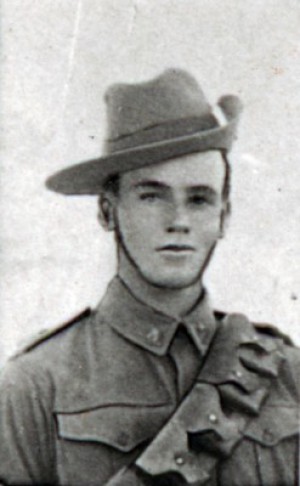Service Details
- Branch of Service
- Army
- Conflict
- World War I (1914-1918)
- Date of Enlistment
- 07/08/1915
- Date of Discharge
- 18/11/1919
- Place of Enlistment
- Liverpool NSW
Personal Details
- Gender
- Male
- Other Name(s)
- Known as 'Harry'
- Date of Birth
- 14/09/1888
- Place of Birth
- Glebe Point NSW
- Address (at enlistment)
- 'The Springs' via Captains Flat NSW (previously Duntroon ACT)
- School(s) Attended
- Captains Flat School
- Occupation
- Grazier
- Next of Kin
- Mary Agnes Tully (mother), 'The Springs' via Molonglo NSW
Unit and Rank Details
- Service Number
- 1558
- Final Rank
- Trooper
- Final Unit
- 12 Light Horse Regiment AIF
Commemoration
Queanbeyan RSL Wall of Remembrance, Crawford St, Queanbeyan NSW
Bungendore War Memorial arch, Gibraltar Street, Bungendore
Roll of Honour at St. Stephen's Presbyterian Church, Lowe Street, Queanbeyan NSW
Notes
Harry Tully was the brother of Jack and David Tully. He lived at 'Duntroon' from 1889 to 1903 where his father was station manager. The family then moved to 'The Springs' near Captains Flat where Tully completed his schoolling and was sent to the Sydney Technical College to study wool classing. He enlisted in August 1915 at Liverpool near Sydney and embarked as a Trooper with the 6th reinforcements to the 12th Light Horse Regiment in November 1915 before joining the 12th Light Horse Regiment in March 1916. His regiment were part of the Suez Canal defences and spent much of the next year patrolling the Sinai desert. On 19 April 1917 they were part of the ill-fated Second Battle of Gaza but by September Tully had fallen victim to an epidemic of septic sores caused by poor diet and living conditions. He recovered to take part in the charge of the light horse at Beersheba in Palestine on 31 October 1917 during which he received a bomb wound to the thigh. Tully rejoined his unit in January 1918 but was hospitalised in February with a septic finger. He rejoined his regiment in May 1918 and spent the summer in the heat and harsh conditions of the Jordan valley. In August 1918 the light horsemen were issued with swords and trained in cavalry tactics which they, including the 12th Light Horse Regiment, used in the Battle of Sharon in September 1918. The British forces quickly rolled up the Turk defenders and Tully and his regiment entered Damascus on 1 October 1918. The following month he succumbed to malaria. He returned to Australia in August 1919 and was discharged on 18 November 1919.
After the war Tully worked as a wool classer and travelled around woolsheds in New South Wales, particularly in the Brewarrina district. He briefly held a soldier settler block near Mount Stromlo in the 1920s (Block 6, Stromlo) but he preferred to work in the shearing sheds rather than settle in one spot. He married Stella Oldfield (from Brewarrina) in 1932 in Sydney and they had two children. Tully eventually retired to Castlecrag in Sydney and by 1955 was living in Manly. He died on 25 February 1978.
Description - height 5 feet 8 inches, weight 154 pounds, ruddy complexion, blue eyes, dark brown hair, Presbyterian.
Sources
Rex Cross, 'Bygone Queanbeyan', 1980
Daphne Duckett & Margaret Robson 'Shepherds' Journey: Tully Family History', 2000 (p.142)
Our Queanbeyan 'Boys', Howard & Shearsby, Yass (postcard)
Queanbeyan Age - 16 April 1915, 11 August 1916, 20 November 1917, 10 February 1920
Sydney Morning Herald - 1 March 1978
Archives ACT 'Repat & Rabbits' web site - https://www.archives.act.gov.au/repatandrabbits/henry_tully
St. Stephen's Presbyterian Church records (Canberra & District Historical Society card index)
NAA RecordSearch - Series B2455 (First Australian Imperial Force Personnel Dossiers, 1914-1920)
